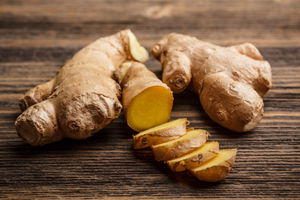Roots: A Year with Morphology~ Using Plant-based Origins to Inspire Aromatic Blending
Posted on January 05, 2015 0
A Year with Morphology~ Using Plant-based Origins to Inspire Aromatic Blending
By Katie Vie
In the spring edition of the Aromatherapy Journal I introduced you to the theme of Morphology: an approach to blending based upon the part of a plant from which the aromatic substance is extracted, and the meaning prescribed to that plant part. In that edition I discussed seeds, and then covered flowers in the summer edition, and wood in the autumn edition.
For the winter edition I will discuss Roots.
In the autumn Aromatherapy Journal I describe spring and autumn as being seasons of transition, while summer and winter feel like seasons of immersion. I say this because summer and winter seem to last longer, and they bring such intensity. Within these two seasons are the solstices, the two days a year when the Earth tilts to its furthest extreme, giving us our longest day and our longest night. Within their extremes, both summer and winter offer opportunity for challenges and blessings.
I relish winter. Granted, I do live in the south, so winters aren't as intense as, say, in Idaho. But the days are still short, the trees that blanket the mountains are bare, and the temperatures are freezing.
What I love about winter is the stillness, the quiet. I love that I'm asleep by 9:00 p.m. instead of just starting dinner. Winter offers a contemplative rhythm to which my own rhythm easily aligns. Winter offers extra time to dream, to gaze, to ground. In Still Life with Woodpecker, the author, Tom Robbins, describes January as ‘”the Sunday of the year.”' Absolutely; without a doubt. A whole month to behave as you would on a Sunday— to focus on reverence and rest, stay in your pajamas, spend hours just having breakfast, cook something slow, take a nap, catch up on the wonderful relaxing things that so often get sacrificed during the work week.
Now, of course winter has its challenges. It's cold, and it's dark. We work very hard to keep our homes warm; an expense that we do not have in the summer. Many of us will also suffer from Seasonal Affective Disorder, orSAD, which involves the symptoms of depression, low energy and lack of motivation. We may also battle dangerous weather conditions. While it would be great to just take January off, as though it were truly Sunday for 31 days, we usually can't. Or don't. This turns the cold, the dark, and the “bad” weather into irritating obstacles instead of just characteristics of a season.
I believe that Aromatherapy, and a slight attitude adjustment, can help us embrace the unsung blessings of this season.
Going with our Morphological theme of Roots, let's look at what roots do, when they do it and how they make us feel. Remember, morphological information is largely intuitive and experience based. You must rely on your own personal associations with each plant part more so than locating this information in a book.
Where I live, in the mountains of North Carolina, I watch the deciduous trees. In the spring they pull stored energy from their roots up through their trunks to unfurl tiny little leaves, as fragile and delicate as a newborn; they also produce flowers dusted with pollen and buzzing with bees. In summer, the leaves swell huge and green, absorbing the energy of the sun during the long days, and produce fruits to ensure proliferation. With the dryness and shorter days of autumn, the trees put on one last glorious show of colorful leaves and then give them up to the winds and the forest floor; exemplifying “letting go.” And now, it is winter. There are no leaves or flowers to prove that the trees live. We know that the trees have sent vital nutrients deep into their roots to help them survive this season of low light. The roots are so deep they will not freeze, nor dehydrate for lack of un-frozen water. When we look across the winter forest with its shadows and variations of gray, we do not see death. We see rest above, and sense gentle yet vital activity below.
Again, while most of us don't take the winter “off,” we can adjust our activity so it's more conducive to what Nature is doing. We can adjust our expectations away from intense productivity, and instead direct energy toward stabilizing, dreaming, conjuring and preparing for growth.
When I described Wood in last season's column I said that a tree, “will go through great lengths so that top and bottom will thrive.” Roots are bottom. They are the foundation, the base.
Let's look at some aromatics that are root based, meaning that the essential oil is found exclusively within the root of the plant:
- Angelica root (Angelica archangelica)
- Ginger (Zingiber officinale)
- Jatamansi (Nardostachys jatamansi)
- Vetiver (Vetiveria zizanioides)

A special note about ginger: ginger is one of my favorite Root oils to work with. I like it because it embodies “grounded fire,” as I call it. Ginger is at once stable and ignited. For those of you who implement ginger into cooking or tea, you know that ginger has a serious heating quality. And yet, it's a root, dug from the dark, cool depths of the ground. I make an anointing oil called, The Queen. It is designed to assist manifestation, and one of its components is ginger essential oil. I include it so that the user will embody the stability of the root, and the fiery passion that comes with the heating quality. A quick tip: get yourself a thermos. Every morning fill a thermos with hot water and about an inch of roughly chopped ginger. I sip it all day throughout the winter. The ginger will increase in intensity as the day progresses. I find that sipping this ginger infusion all day keeps me warm, keeps my immune system bolstered and staves off extra wintertime cravings.
So, remember that when you are implementing Morphology into your blending techniques you are weaving intuitive, experience based information into the chemistry, actions, indications and protocols that you already use. Some morphological indications for using Root essential oils would be:
- A need for grounding.
- A connection to the present or the natural world.
- To strengthen or establish a foundation/base.
- For quiet introspection.
- To instill faith/trust.
- To foster the ability to rest.
- To improve patience.
- To make a connection to the ancestors.
- To encourage stillness/quiet.
- To deepen any practice.
- To “get to the bottom” of something.
Roots are the very definition of grounding. There is a meditation I always use at the start of a class. In it I say something like, “you are grounded and centered, like a tree. You extend into the world; you are moved and shifted and swayed by it, but you do not lose your place.” Roots provide stability and connection for a plant. They also allow a plant to eat and drink; bringing vital nutrients from great depths and distances while the tree stays put. Roots are also unseen (usually), and carry with them a quiet mystery of the dark, subterranean worlds where they dwell.
So what is “grounding?” Grounding is your ability to connect and stabilize. It's also the ability to diffuse intense energy, sending it toward a bigger, more capable source; similar to how a lightning rod works. Have you ever been in a situation that mounts in intensity, and by the time it is over you feel frazzled, lost, or blown apart? It is likely you were not grounded. Grounding protects your structural integrity and gives you full access to what your “roots” can bring you: support, nutrients, information, etc. that may seem far away, but thanks to your roots is easily transported to your center. There's an image of a tree— a line drawing that shows the branches are exactly mirrored by the underground roots. To be stable, to have proper support, your unseen “roots” must be as developed as your “look-at-me-and-how-big-I-am!” branches.
There are levels to being grounded. You must be grounded in general, as a person. You must also be grounded in any given situation. Sometimes grounding comes easily. We take being grounded for granted the way we do our heart beat. Other times we need to be intentional about being grounded, like when we're traveling, or around people who knock us off center.
Anytime you weave these Root essential oils into a blend, you are invoking “grounded-ness.”
Ground & Focus
In situations where you need to be stable and alert, like public speaking, you will want to blend Root essential oils with something stimulating and uplifting, like citrus or mint essential oils.
Ground & Trance
When working within Shamanic practices or deep meditation you will want a sense of “anchoring” and freedom to soar away from mundane existence. Here I would suggest pairing Root essential oils with Clary sage (Salvia Sclarea) and resin based essential oils.
Ground & Quiet
When there is difficulty quieting the mind and coming to deep stillness, blend Root essential oils with nervines like lavender (Lavandula angustifolia), or conifer needle oils which are harvested in the deep quiet of winter.
I wish each of you all the peace that this season has to offer. May you deepen your love and understanding of aromatherapy by implementing Root essential oils into your aromatherapy blends.
About Katie Vie
 Katie Vie has been immersed in the fragrant world of aromatherapy nearly half of her life. Katie's work is a marriage of therapy and beauty; a delight for the senses. She lives in Asheville, North Carolina with her dog and a Pirate. Katie designs and blends a body care line called river island apothecary. In 2015 she will launch the Asheville School of Aromatherapy where she will offer Aromatherapy certification, the Sacredness of Self program, and the Reviving the Muse program from her newly built apothecary. She can be found at www.katievie.com.
Katie Vie has been immersed in the fragrant world of aromatherapy nearly half of her life. Katie's work is a marriage of therapy and beauty; a delight for the senses. She lives in Asheville, North Carolina with her dog and a Pirate. Katie designs and blends a body care line called river island apothecary. In 2015 she will launch the Asheville School of Aromatherapy where she will offer Aromatherapy certification, the Sacredness of Self program, and the Reviving the Muse program from her newly built apothecary. She can be found at www.katievie.com.
Comments
No comments yet for this entry.
Please Log In to post comments